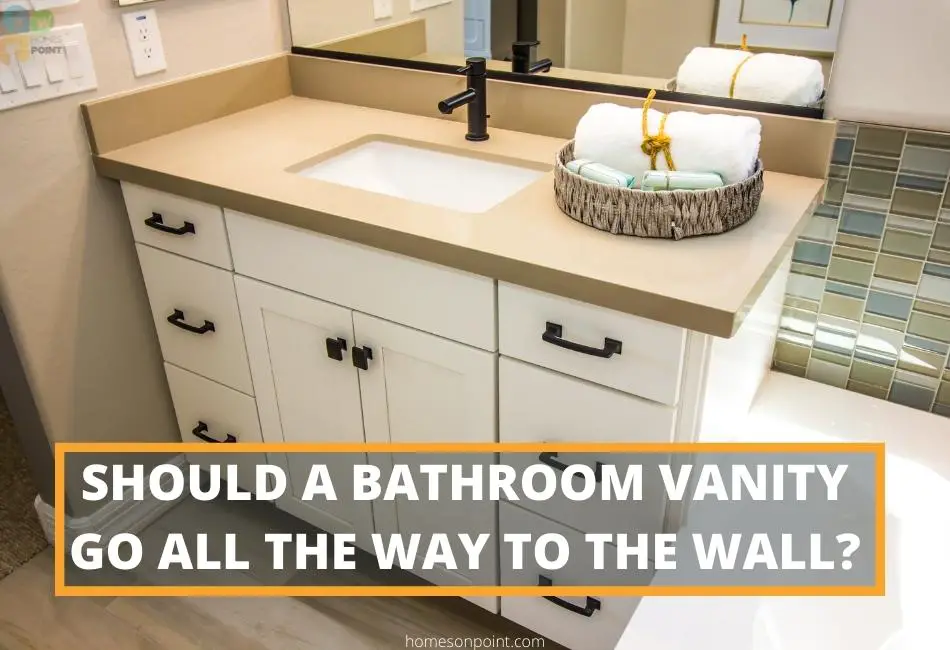Over the years, bathroom vanities have evolved in both style and function. Today, there are many different types and designs of vanities to choose from. But one question that often arises is whether or not a bathroom vanity should go all the way to the wall.
Ideally, bathroom vanities should be installed so that they are flush against the wall. This is for both aesthetic and functional purposes. But, there are always exceptions to the rule and you may find that your bathroom layout works better with a vanity that is not flush against the wall.
What Is A Bathroom Vanity?
A bathroom vanity is a piece of furniture that is typically used to store bathroom essentials such as towels, toiletries, and bathroom cleaning supplies. A bathroom vanity is usually composed of a cabinet, countertop, and sink. Some bathroom vanities also come with additional features such as mirrors, lighting, and storage. The storage space could sit under the sink or above it.
Bathroom vanities are available in various sizes, designs, and materials to suit any bathroom space.
Do All Bathroom Vanities Need To Be Attached To The Wall?
As indicated earlier, it is ideal for installing a vanity against the wall to create a cleaner and neater look as there are no gaps between the wall and vanity. But not all bathroom vanities need to be attached to the wall.
In fact, there are many different types of bathroom vanities that are not attached to the wall. These include free-standing vanities, corner vanities, and floating vanities.
Free-standing vanities are, as the name suggests, vanities that are not attached to the wall and can be placed anywhere in the bathroom. These vanities are ideal for small bathrooms as they do not take up much space.
Corner vanities are another type of vanity that is not attached to the wall. As the name suggests, corner vanities are placed in the corner of the bathroom and are ideal for small spaces.
Floating vanities are vanities that are mounted on the wall but do not touch the floor. This gives the illusion of a floating vanity, hence the name. Floating vanities are ideal for small bathrooms as they make the space appear larger.
So, there you have it! Bathroom vanities do not necessarily need to be attached to the wall. It all depends on your personal preference and the size and layout of your bathroom.
Why Are Bathroom Vanities Put Against The Wall?
There are several reasons why bathroom vanities are put against the wall.
1. Creates A Cleaner Look
When a bathroom vanity is against the wall, it creates a cleaner look. There are no gaps or spaces between the wall and the vanity, so it looks neater. This can be especially important in small bathrooms, where every square inch counts.
2. Security For Storage Space
Another reason to put a bathroom vanity against the wall is to maximize storage space. When the vanity is flush with the wall, you can store things on top of it or in the cabinets beneath it without worrying about them falling behind the vanity.
If you keep things on top of the vanity or in the cabinets, it will be very annoying to have them toppling over and falling out down the back of the sink. This is likely to happen if your bathroom vanity is not put against the wall.
3. Stability
Bathroom vanities which are attached to the wall are more stable. You do not want a situation where you accidentally bump into your vanity and it shifts. Neither do you want to realize that with the passage of time, your bathroom vanity has drifted from the original position where you placed it. When the vanity is flush against the wall, this will not happen.
4. Helps To Maximize The Space In Your Bathroom
Another reason to have your bathroom vanity against the wall is to help maximize the space in your bathroom. If your bathroom is small, you want to make use of every square inch. Putting the vanity against the wall can help you do that.
Of course, it will also depend on the size of the vanity. However, I would like to believe most people choose a vanity while considering the size of their entire bathroom.
5. Plumbing Convenience
Last but not least, having the bathroom vanity against the wall is also more convenient for plumbing. All the pipes and connections are hidden behind the unit, so you don’t have to worry about them being on display. This can be a major consideration if you’re not keen on having plumbing visible in your bathroom.
Also, getting access to pipes and drains especially for repairs is even much simpler. You don’t have to remove the entire unit just to get to a single pipe.
Exceptions To Putting Bathroom Vanity Against The Wall
On one side of the coin, for the most part, it is better to have your bathroom vanity against the wall. On the other side, there is no hard and fast rule for that installation and there may be reasons why the bathroom vanity cannot or should not be against the wall.
1. Space
If you have the space, why not? Sometimes, one reason why people choose to have the bathroom vanity against the wall is because of space. If you have a very large bathroom, you may want to put the vanity away from the wall to create more of a statement.
2. Aesthetics
In some cases, the bathroom layout or the shape of the room may dictate that the vanity is not placed against the wall. This is especially true for odd-shaped bathrooms. If the vanity is not placed against the wall, it can help to create a more balanced look in the room.
3. Indifferent About A Backsplash
If you really don’t care about having a backsplash or you’re planning to install one later, then it doesn’t matter where you put the vanity. You can put it in the middle of the room if you want. Just be aware that without a backsplash, water can easily splash onto the wall and cause damage.
4. Access To Outlets
If you need to have easy access to outlets for things like hair dryers and curling irons, then you may want to put the vanity away from the wall. This way, you can plug in these devices without having to reach behind the vanity or move it out of the way.
5. Personal Preference
At the end of the day, it really comes down to personal preference. If you like the way your bathroom looks with the vanity away from the wall, then go for it. There is no right or wrong answer when it comes to this issue.
Final Words
In most cases, the big answer is yes you should attach your vanity to a wall. What’s more, it needs to be flush against said surface and have no space between them for plumbing reasons, as most of these fixtures will come through holes in walls underneath or behind sinks where they hide from view (and potential damage).
A vanity can shift accidentally or with time if not attached to the wall and if that happens, it could put a strain on the plumbing because the sink is attached to the vanity and the plumbing. this can cause leaks at the joints.
If none of these reasons are a concern for you, and you really want that floating look in your bathroom, then by all means go for it.

